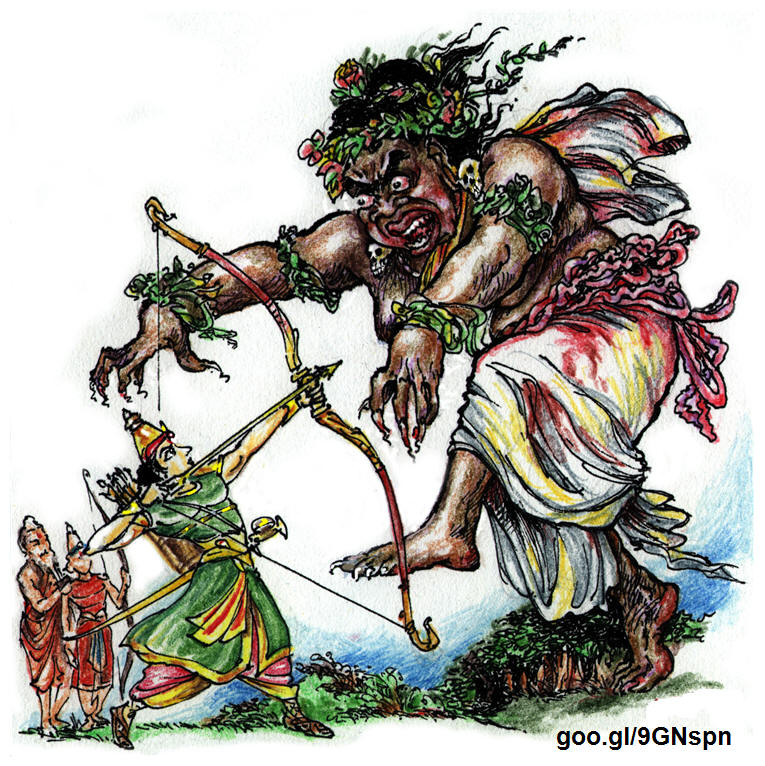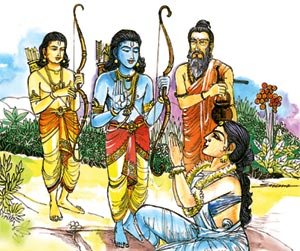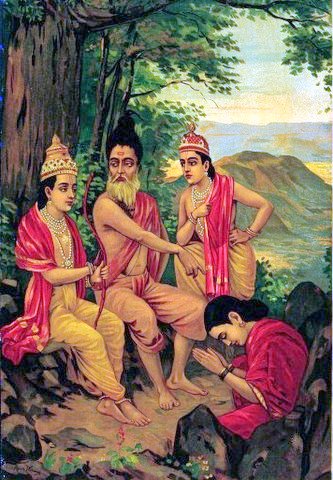சக்தி விகடன் -
29 Jul, 2007
சிறுகதை
Expanded version of the stories by
Veeraswamy Krishnaraj
|
Traditionally for worship, we regard God as male and Sakthi as
female.
Except for Fish and Boar incarnations, the other incarnations
are largely in the form of man.
Sivaperuman, Parvathi, Vinayakar, Murugan…appear in human
form. Incarnation as God on earth, entails holy feet, holy hands
as the determining features. They are superior and transcend
man’s counterparts. This is difference between man and God.
Suketu wanted a son, performed austerities
but begot a girl (Tatakā
with the strength of 1000 elephants) by the boon of Brahma. She
married a prince Sunda and begot two sons Marīcha
and Subahu. Sunda died from the curse of Agastya.
With the husband dead, Tatakā with her son Marīcha went
to kill Agastya, who cursed her to become an ugly cannibal and
him a Rākṣasa by transmutation Her son by Agastya's curse became a demon. Tatakā lived in a forest near Ganges, known
as Forest of Tatakā. She devoured the trespassers. The forest
dwelling Rishis were the recipients of her wrath, including
Viśvāmitra. She and her son Subahu destroyed the Yagnas raised
by the Rishis by contaminating them with blood and flesh.
Viśvāmitra went to king Dasaratha complaining about Tatakā and
seeking help. The king sent his teenage sons Rama and Lakshmana
to protect Viśvāmitra and his Yagnas. Tatakā was sighted by Viśvāmitra, who asked
Rama to kill her. Rama hesitated because the perpetrator was a
woman. He mutilated her by cutting her hands. She immediately
disappeared into thin air literally and attacked them in her
incorporeal form. Viśvāmitra reminded Rama that as a prince
he was duty-bound to kill the enemies of seekers of justice. The
moment Rama saw her, he pierced her heart and down and dead
Tatakā was the next moment. Rama received the blessings of
forest sages.
The Bhakti literature explains these differences very minutely.
In the human form of MahaVishnu as Rama, his persona resemble
that of man. Muni Viśvāmitra took Rama to safeguard his fire
sacrifice. The Muni asked Rama to kill Thatakā . The Sattvic
Rama thought, “Is she not a woman? Can I kill her?”
Viśvāmitra: She is not a woman. She is an ogress! Kill her
forthwith.”
Upon receiving the orders from the Muṉi, Rama took an aim at
Thatakā
with his arrow and killed her.
Because of killing of the strong ogress, the Muni understood the
Amāṉuṣya
Sakthi (superhuman) of Rama. Rama, Lakṣmaṇā
and the Muṉi walk towards Mithilā. Rama’s foot falls on a huge
boulder. Immediately the rock morphs into a woman. Seeing this
transformation, Rama asks “Who is she?” Viśvāmitra sys, “She is
Akalikai. The woman morphing into a stone from Gautama Muni’s
curse, transformed back again into a woman upon the fall of
Rama’s foot on the stone. That is when Viśvāmitra realizes that
Rama was a Supreme Being.
Gautama-Ahalya-Indra. Ahalya’s petrification.
Brahma created
Ahalyā by taking all that is beautiful in the universe and
putting them together and creating Ahalyā to smash the pride of
Urvashi, the foremost beauty in heaven and earth. The basic
substance in her creation was water. Yes, we are all 60% water.
Ahalyā means unploughed. Several meanings are attributed to the
name. There are several stories about her origin.
Brahma gave
Ahalyā to the care of Sage Gautama until she attained maturity.
Gautama takes Ahalyā to Brahma once she attains menarche. Brahma
impressed by Gautama's sexual restraint gives him permission to
marry her. Indra, the chief of gods became jealous and felt all
beautiful women are his to have and hold.
Gautama and
Ahalyā lived by a river with her aged husband.
Indra arrived to the Ashram, when Gautama was bathing in
the river. Indra came in the guise of Gautama and seduced her.
Ahalyā unknowing of Indra's disguise, gives in to his
advances to have sex with him thinking she was having sex with
Gautama
Gautama
discovering her encounter questioned her why she did not notice
Indra's mannerisms (different from his. One text says she finds
her lover was an impersonator half way during the act.) cursed
her to become a stone with a promise of redemption by Ram's foot
falling on the rock. Why stone? She acted like a rolling stone
not sentient of the difference between him and Indra. Indra ran
away as a cat. He cursed Indra to lose his testicles. Further,
his body by Gautama's curse carried the tattoos of a thousand
vulvae. Indra became the poster boy of illicit sex.
‘Hereafter, the grief of the humanity will go away.
The purpose of Ramāvathāra
having been fulfilled, the world of beings will thrive. Rama’s
persona proves he is the Supreme Being. That I understand.’ So,
said Viśvāmitrar.
The following poem plays on the word வண்ணம் (Vaṇṇam).
இவ்வண்ணம்
நிகழ்ந்த வண்ணம்
இந்தப் பாட்டில் எத்தனை வண்ணம்! ஒவ்வொன்றுக்கும் வெவ்வேறு பொருள்:
இவ்வண்ணம் நிகழ்ந்தவண்ணம் = இப்படி நடந்தபடியால்
= It happened this way
அரக்கி தாடகையுடன் போர் செய்தபோது
= Ogress Thātaki, When fighting with
When the leg of Rama stepped on a rock, it transformed into a
woman relieved of a curse to become a stone long ago.
https://nchokkan.wordpress.com/2013/06/
It happened so, hereafter this whole world will not suffer grief
but enjoy wellness. When
there was a war with collyrium-colored ogress Thatakā i, O
nimbus-cloud-colored Rama, I saw your handsome hands (the
deeds). I saw the
beauty (and grace-offering) of your leg here
This is Kambaṉ’s
poetry. Killing of Thatakai
and the release of Akalikai from her curse are the changed
events. The Muṉi
realizes, ‘This is how God differs from man.’
With his hands, man pays homage, gives, embraces…
Simultaneously in an act of opposition, he will kick with his
foot, grinds and destroys.
If God thinks of destruction, he destroys by discharging an
arrow, wielding the sword, hitting with the club, and launching
the discus. If he thinks of offering grace, he confers with his
holy feet and embrace with his hands Rama destroyed Thatakā
i with his hand and conferred grace with his feet. That
differential deed made us realize he is the Supreme Being. There
is proof of this in the ancient Tamil literature.
Nakkīrar
says, ‘Murugaṉ
holds and supports his servitors by his holy feet. He destroys
his opponents with his long thunder-and-lightning-like arms. Man
embraces with his hands and kicks with his feet; God embraces
with his feet and destroys with his hands.
|


